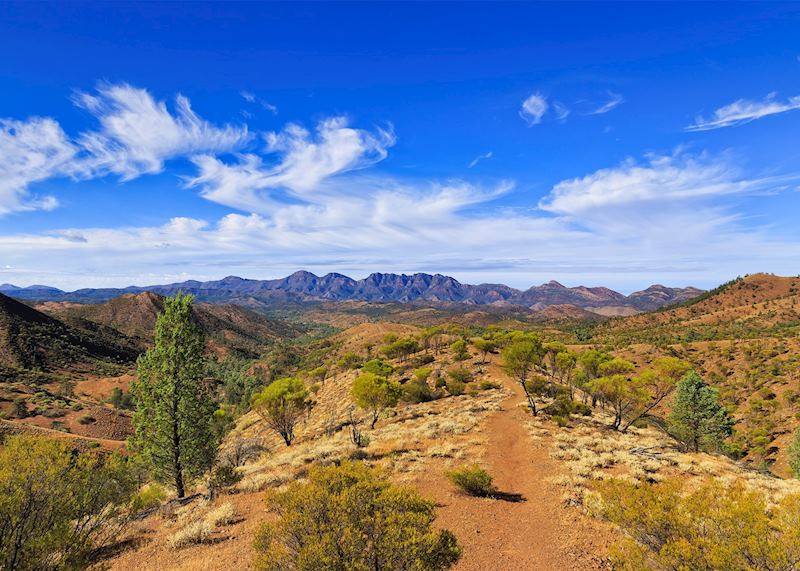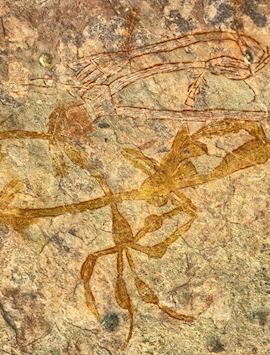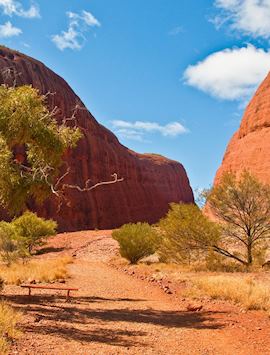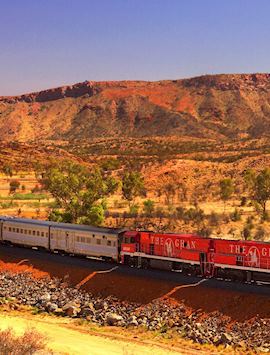By Australia specialist Lee
There’s scarcely a more quintessential Outback experience than a journey aboard The Ghan. Weaving between lunar-like deserts, towering rock formations, and tropical forests, it’s a first-class portal into Australian environments that are otherwise unreachable. But, to truly connect with this continent of otherworldly landscapes, you’ve got to go beyond the tracks: explore the leafy cityscapes, sample vintages at world-class vineyards, cruise sun-dappled waterways, and embark in wildlife spotting across tranquil plains.
This guide has a dual function. To help you decide whether The Ghan is right for you, I’ve detailed all the useful bits you need to know about the rail journey and the experiences you can have along the way. As an addition, I’ve also curated a list of experiences that complement the voyage, so you can create a trip (like this one) that delves deep into Australia’s many facets.
All about The Ghan
Why The Ghan?
Thick forests of mangrove trees, rusted-red desert plains, towering quartzite ridges that stretch beyond the horizon… Each time you peer out of the picture-frame windows of The Ghan, a new otherworldly landscape awaits. This is the appeal of the chrome-covered locomotive. Speeding across the heart of Australia, it offers you an old-fashioned rail journey through extreme environments that are otherwise inaccessible to most.
But that’s not the limit to its attractions. Not only is it the longest passenger train in the world, part of its tracks (between Adelaide and Alice Springs) date back to the early 20th century. It’s also alleged that its history traces back further: to 19th-century Afghan cameleers who would regularly wander the route as part of the Outback’s pastoral industry.

Where can I go on The Ghan?
There are a few variations on the route. The train line stretches between Adelaide and Darwin, with options to either travel the full expanse (in either direction) or opt for a shorter itinerary that begins or ends in Alice Springs. For the most in-depth experience, I suggest taking The Ghan Expedition, which spans four days and three nights, and stops at some of Central Australia’s must-see destinations.
Board at Darwin, and you’ll be whisked off to the maze-like gorges and trickling waterfalls of Katherine by late afternoon. Here, you’ll have your first taste of exploring off the train — many of The Ghan’s wide selection of experiences en route are included in the price of your ticket. You might choose to take a lilting boat ride down Nitmiluk Gorge, observing the imposing rock faces with a Jawoyn guide. Or, perhaps, you’ll venture deep into Cutta Cutta’s limestones caves, where you can observe rare ghost bats flitting between the stalactites.
Pressing south, there are more immersive activities for you to choose from in the Outback towns of Alice Springs. including an opportunity to fly over to Uluru and explore the landmark on a comprehensive tour (if you’re prepared to pay a bit extra). and, including a visit to an underground church, scenic flights over contoured ranges, tours around subterranean opal mines, and even the opportunity to fly over to and explore the landmark on a comprehensive tour (if you’re prepared to pay a bit extra).
Another exciting stop along the way is Coober Pedy. You may not have heard of this one, but to me, it’s one of the most fascinating places in all of Australia. As an opal mining town, much of it is underground, and during your stop here, you can see how the residents live: visiting an underground church and touring working opal mines. Alternatively, for more of the Outback, you might take a scenic flight over contoured ranges.
As a food lover, though, I believe some of the best experiences happen at mealtimes — and one highlight of The Ghan Expedition is the Outback dinner at Alice Spring’s historical Telegraph Station, where you’ll dine on barbecued regional cuisine under a speckle of glittering stars.

What’s the onboard experience like on The Ghan?
You can expect truly high standards throughout your all-inclusive journey. Your meals (multi-course at lunch and dinner) are served in fine-dining restaurant cars and consist of seasonal, farm-to-table Australian fare, such as crocodile tail fillet, grilled barramundi, and select cheeses from the Barossa Valley.
For drinks, the bar has plenty on offer no matter what carriage you’re in (more on that later). You have choice from a comprehensive list of premium Australian wines, spirits, barista-level coffees, and non-alcoholic beverages — all of which you’ll enjoy in luxurious, wood panel lounges decked out with plush leather seats.
As for the entertainment — in those few hours you aren’t exploring — you’ve got books, games, and even musicians in the lounges at set hours to pass the time. Although, I’m personally of the opinion that there’s no performance quite like the changing shapes outside the train window, which are more than enough alone to keep the conversation flowing.
There are three different types of carriages available for you to choose from aboard The Ghan: Gold, Gold Premium, and Platinum, and you can expect a different level of experience in each (for example, you’ll receive up to four courses at dinner in Platinum). You can speak to me or another one of our Australia specialists to find out which would be the best fit for you.

Beyond the rails: 5 experiences to enhance your train journey
1. Getting a taste of laidback city life in Adelaide
If you’re taking one of The Ghan’s full-length journeys, you’ll either start or end in leafy Adelaide. To make your trip more comfortable, it’s always worth spending at least the night here — but I’d argue South Australia’s state capital warrants more of your time.
With its wealth of cultural institutions, first-rate markets, and easy-to-reach city beaches, Adelaide offers a stark contrast to the Outback landscapes of the train. After several days of guided experiences, you might also wish to set out on your own —the relatively compact city is highly walkable. In fact, it’s even been designated “national park city” status.
You could head on over to North Terrace, the city’s cultural hub, to delve into Indigenous culture at the South Australian Museum. Or, maybe you’ll check out the National Wine Centre situated in the Botanic Gardens, boasting the largest open cellar in the Southern Hemisphere with a collection of wines to match.
Cricket fans can visit the historic Adelaide Oval, the location of Australia’s first ever Test match, as well many legendary sporting moments (the 2006 Ashes comes to mind). You might even reach new heights climbing the Oval’s sleek arc, where you’ll see views across the city to the ocean and rolling hills.
For something a bit more structured, I’d be delighted to arrange for you a tour of Adelaide Central Market. The largest fresh produce market in the Southern Hemisphere, there’s a little something of everything among its 80 stalls, and you’ll spend the morning enjoying tastings like lemon-myrtle infused tartlets and South Australian goat brie.
After the tour, you can explore the market at your own leisure or enjoy a meal at one of the many eateries frequented by locals.

2. Sampling world-class wines in the Barossa Valley
Adelaide is your gateway to the undulating hills, storied Germanic towns, and world-class vineyards of the Barossa Valley, only a 50-minute drive away. This fertile region is as different from the stark, dusty Outback as you can get. Plus, a visit here is a great opportunity to see how that velvety shiraz (or peppery cabernet sauvignon) you sipped aboard The Ghan came into fruition.
My advice would be to indulge in a few days in the valley, appreciating its slower pace and wandering wineries both independent and international (from Château Tanunda to Jacob’s Creek).
To really unwind, you might spend a night or two at The Louise. Nestled within the heart of the valley, its grand villa-style suites look out onto rows upon of rows of shiraz-grape vines, as well as bushes of lavender, shrubs of rosemary, and thickets of gum trees in the distance.
It’s worth it alone for The Louise’s restaurant, Appellation, which provides fine dining at its most Australian. For dinner, you can expect dishes such as hand-dived Kangaroo Island scallops, sweet Davidson plum duck, and floral lemon myrtle meringue, each with a complementary Barossa Valley wine.
If you’re pressed for time, there’s also the option of taking a day tour from Adelaide. Most privately guided tours may be adjusted for your interests, but you should be prepared to see larger award-winning estates, as well as smaller cellar doors — sampling variations on bold, powerful, full-bodied red, white, and sparkling wines along the way.
You can experience similar tours in nearby cooler, hillier Adelaide Hills (known best for its crisp chardonnay) if one major Australian wine region simply isn’t enough.

3. Exploring the Outback at the Flinders Ranges
A journey aboard The Ghan offers you a glimpse into the Red Centre’s tapestry of deep ravines, weathered canyons, and blood-and-ochre hued megaliths — but Ikara-Flinders Ranges National Park is another level all together.
Hiking Wilpena Pound, a behemoth of quartzite at the park’s nucleus, is one of my fondest memories of Australia. Feeling entirely isolated from the rest of the world, we “bushwalked” around this giant, pyjama-striped circle all the while listening to our guide explain (in a diphthong-heavy drawl) about the different flora, fauna, and bush food thriving in this unforgiving habitat.
Along the way, we spotted grey kangaroos and yellow-footed rock wallabies sunning themselves on the rockface, and even an echidna plodding through the shade.
However, hiking isn’t the only way to connect with this martian landscape. To cover even a sliver of the full national park, you’ll need to take a 4x4 tour to cross its vast plains and bumpy creek beds. I also recommend a scenic flight of the area to access those bits even the 4x4s can’t get to — and to witness Wilpena Pound in all its amphitheatrical glory from above.
The Flinders Ranges are a four-to-five-hour drive from Adelaide, so it’s worth staying at least a single night — thought it definitely warrants staying a few more. I can’t speak highly enough of the eco-villas at Rawnsley Park Station, which sit in the shadow of Wilpena Pound itself.

4. Searching for wildlife on Kangaroo Island
Hordes of Australian sea lions snoring on ice-white sands. Solitary koalas stretching between eucalyptus trees. Glossy black cockatoos chirping squeakily as they flit between drooping she-oak branches. This is Kangaroo Island, stomping ground for a pick-and-mix of Australia’s most eccentric wildlife.
Because it’s just a 30-minute plane ride from Adelaide, I always advise my clients to stop by the island, especially as animal sightings are rare in the city or from The Ghan. Here, however, you’re in for a treat. You can’t move for wildlife interactions, especially with kangaroos, wallabies, and echidnas, which you’re bound to spot on a small-group (or private-guided) tour across the national parks.
Moving by custom-made 4x4, you’ll dart between farmlands, river valleys, plateaus, and rocky coastlines with binoculars in hand trying to find the island’s wild inhabitants. On my tour, all the guides were locals, so they knew just where to go to get those camera-worthy moments. Another highlight was our picnic in the bush, where they cooked up a seafood barbecue while we sat surrounded by grazing grey “roos.”
It’s worth taking a few days to really soak up the atmosphere on Kangaroo Island. There’s lot of different accommodation types to choose between, from self-catering to ultra luxury villas. One I like especially is family-run Stranraer Homestead, a farm-stay on a working sheep farm that overlooks the island’s tamer pastures.

5. Cruising the Darwin’s diverse landscapes
Thanks to its rich Aboriginal history, deep purple-pink sunsets, and proximity to crocodile zones, Darwin is addictive. I have clients so smitten with the tropical city that they just keep coming back. Which is why, whether you board or alight at Darwin Berrimah Terminal, I believe it’s a worthwhile bookend to your trip aboard The Ghan.
If you’ve got less than a day in the city, you can’t go wrong with Mindil Beach and its corresponding market (operating every Thursday and Sunday from April to October). Unlike most markets, this one runs from late afternoon into early evening, so patrons can watch as the sun sets (burnt orange, then red, then purply-pink before turning indigo blue) over the Arafura Sea. Southeast Asian influence is strong in the cuisine here, and you can’t go wrong with a spicy laksa (curried coconut noodle soup) to slurp at the beachside while you take in the view.
Alternatively, you can experience one of these showstopping sunsets on a cruise around Darwin Harbour. While onboard, you’ll enjoy a locally inspired meal packed with seafood, and learn all about the city’s history, including its significance in World War II and importance to the Indigenous Larrakia people.
For those interested in spotting a few freshwater crocodiles, I’d urge you also to venture over to Litchfield National Park, just under a two-hour drive away.






